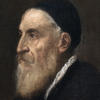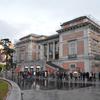More about Emperor Charles V at Mühlberg

Sr. Contributor
Pre-dating Tyra Banks by over four centuries, Titian and Charles V pioneered the side angle technique for enhancing cheekbones and a sharp jawline in Charles V on Horseback.
Charles V was the Holy Roman Emperor, King of Spain, and a staunch Catholic. He presided over a large territory, his rule extending from Germany to Italy to the Netherlands. He ruled during the time of the Protestant Reformation, a period of religious upheaval in Europe, and this painting was commissioned to celebrate his victory over the Protestants in the Battle of Muhlberg in 1547, the end of the Schmalkaldic War between the Catholic Holy Roman Empire and the Schmalkaldic League, the alliance of Lutheran rebel princes. This important commission was given to who else but Titian, a Venetian painter during the Italian Renaissance, who was highly sought after by prominent Italian patrons and the papacy and who Charles had sat for previously in Charles V with a Greyhound.
Although Charles boasted an impressive resume, he was no Prince Charming, at least aesthetically, and was insecure about his protruding Hapsburg chin, the result of many years of royal inbreeding. This was one of the challenges Titian faced when creating the portrait, to achieve a balance of true representation and idealization fit for a monarch. He decided to depict Charles on a horse to reconcile these two considerations, choosing to conceal half of his face and finishing it with gentle retouching instead of full-on profile shot that would have required extensive photoshop to reconstruct him as the ideal beauty, the 1548 version of People Magazine’s Sexiest Man Alive.
The Hapsburg dynasty and his chin were not the only things that Charles inherited, as the years of inbreeding was also the cause of poor health and was known to suffer from chronic gout, thus, the addition of the horse. Alongside his gout, he was also a gourmet. He loved highly spiced foods and beer and consumed them in large quantities, which only worsened his condition. He was frequently confined to his bed and the litter, a medieval man-powered wheelchair for the monarchy, was his preferred method of transportation in times of frailty.
The painting is only a half-lie, and there are elements in this painting based on truth. The armor he is shown wearing is the actual armor that Charles wore into the Battle of Muhlberg, and is currently located in the Royal Armory in Madrid. The horse is a nod to his horsemanship. The Spanish army was even said to have lost its best horseman when Charles became emperor. The quote, “I speak Latin to God, Italian to women, French to men, and German to horses” is sometimes attributed to Charles. Whether or not he uttered that phrase or did indeed speak to his pferd auf Deutsch (“horse in German” in German), Charles’ rapport with horses was widely known. Based in fact, the inclusion of the horse is also a statement of power. Equitation was also seen as a noble pursuit, and his light and controlled hold on the reins combined with the gracefully lowered head of the obedient horse is also a statement of Charles’ ability. A loosened grip is a reference to Xenophon’s treatise Hipparchicus, which states that a loosened grip lets the horse “prance in a fine style”, the style in which “gods and heroes ride”. The portrait is also reminiscent of the equestrian statue of the first Christian emperor, Constantine. This depiction was so effective in creating the image that Charles wished to be portrayed as that it inspired later depictions of the emperor, including Van Dyck’s similarly titled Portrait of Charles V on Horseback.
This painting was not simply a 16th century vanity portrait, and was meant to be a form of political propaganda. Although Charles was a devout Catholic, his primary goal was to keep peace and unity in the empire, and he offered concessions to the Protestants after the war in the Augsburg and Leipzig Interims. The powerful horse and the dark, atmospheric background combined with Charles’ armour and steely gaze gave him a facade of power beyond the corporal, depicting him as an austere ruler, capable of leading a heterogeneous state. Titian portrays Charles through Dante’s allegorical image of a monarch-savior, a good ruler who leads without force just as a horse willingly obeys a rider’s command, representing him as a Christian ruler leading his people to spiritual rebirth.
Sources
- “Emperor Charles V at Muhlberg.” El retrato del Renacimiento. Museo Nacional del Prado. 2008. 388-389.
- “Equestrian Portrait of Charles V, by Titian.” Titian.org. Accessed July 24, 2019. https://www.titian.org/equestrian-portrait-of-charles-v.jsp
- Freeman, Luba (1995). Titian's portraits through Aretino's lens. Penn State Press. 125-133.
- Glück, Gustav. "Van Dyck's Equestrian Portraits of Charles I." The Burlington Magazine for Connoisseurs 70, no. 410 (1937): 211-17. http://www.jstor.org/stable/866919.
- Grancsay, Stephen V. “The Parade Shield of Charles V.” The Metropolitian Museum of Art Bulletin, Volume 8, No. 4. December 1949. 123-132.
- Hemphill, Dom Basil. "The Monastic Life of the Emperor Charles V." Studies: An Irish Quarterly Review 37, no. 146 (1948): 140-48. http://www.jstor.org/stable/30099766.
- Jameson. "Lives of the Early Painters: Titian." The American Art Journal (1866-1867) 6, no. 22 (1867): 339-42. http://www.jstor.org/stable/25306914.
- Robinson, Fred C. "The History of English and Its Practical Uses." The Sewanee Review 112, no. 3 (2004): 376-95. http://www.jstor.org/stable/27549549.
Featured Content
Here is what Wikipedia says about Equestrian Portrait of Charles V
Equestrian Portrait of Charles V (also Emperor Charles V on Horseback or Charles V at Mühlberg) is an oil-on-canvas painting by the Italian Renaissance artist Titian. Created between April and September 1548 while Titian was at the imperial court of Augsburg, it is a tribute to Charles V, Holy Roman Emperor, following his victory in the April 1547 Battle of Mühlberg against the Protestant armies.
The portrait in part gains its impact by its directness and sense of contained power: the horse's strength seems just in check, and Charles' brilliantly shining armour and the painting's deep reds are reminders of battle and heroism. According to Hugh Trevor-Roper, he "does not exult in his victory. He is staid, controlled, pensive, but serene". Titian recorded all of the foreground elements—the horse, its caparison, and the rider's armour—from those used in the actual battle. Both the armour and harness survive, and are kept at the Royal Armoury in Madrid. It was in the Spanish royal collection until transferred to the Museo del Prado in 1827.
Check out the full Wikipedia article about Equestrian Portrait of Charles V













I love the way that the horizontal paint stokes are apparent in this painting. You can specifically tell this by the way that the sky was painted. All of the colors mesh so well together, and the horse obviously looks like it's ready for battle by the way it's dressed, and its obvious unsettledness. Although the soldier in this painting also looks like he's ready for war, if you look closely, you can see that the soldier has a calmness in his face that really gives the painting a peaceful tone. I especially love the way that Titan painted the sky many different colors, giving the painting an even more mysterious tone.